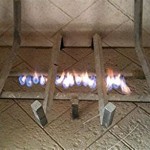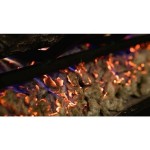Infrared Fireplace Reviews
Infrared fireplaces have grown in popularity in recent years, offering a compelling alternative to traditional wood-burning or gas fireplaces. These modern heating appliances utilize infrared technology to generate heat, providing a unique and efficient way to warm your home. This article will delve into the world of infrared fireplaces, exploring their key features, benefits, and drawbacks, ultimately equipping you with valuable insights to make informed decisions about your heating needs.
Key Features of Infrared Fireplaces
Infrared fireplaces operate on a different principle than conventional fireplaces. Instead of heating the air directly, they emit infrared radiation that warms objects and people in its path. This direct heat transfer makes infrared fireplaces exceptionally efficient, as the heat is not lost through air circulation. The following highlights key features of these innovative heating appliances:
- Direct Heat Transfer: Infrared fireplaces use infrared radiation to warm objects directly, rather than heating the surrounding air. This direct heat transfer makes them highly efficient and can provide a more comfortable warmth.
- Energy Efficiency: Infrared fireplaces are generally more energy-efficient than traditional fireplaces, as less heat is lost through the air. They can significantly reduce energy consumption and lower heating costs.
- Rapid Heating: Infrared fireplaces can heat a room quickly, often reaching their full heating capacity within minutes. This makes them ideal for instant warmth and can be particularly advantageous in colder climates.
- Safe and Clean: Infrared fireplaces are generally considered safer than traditional fireplaces, as they produce no smoke, ash, or embers. They also do not require a chimney or ventilation system, making them suitable for various locations.
- Versatile Designs: Infrared fireplaces come in various styles and sizes to suit different preferences and decor. From sleek modern designs to traditional styles, there's an infrared fireplace to complement any home.
Benefits of Using an Infrared Fireplace
The unique features of infrared fireplaces translate into numerous benefits for homeowners. These benefits make them a compelling choice for those seeking efficient, safe, and aesthetically pleasing heating solutions for their homes.
- Improved Energy Efficiency: Infrared fireplaces are known for their high energy efficiency, as they directly heat objects rather than the air. This can significantly reduce energy consumption and lower heating costs, making them an environmentally friendly option.
- Faster Heating: Infrared fireplaces heat up quickly, providing instant warmth within minutes. This feature is highly desirable for those seeking rapid heating solutions, especially during cold winter months.
- Enhanced Comfort: The direct heat transfer of infrared fireplaces creates a comfortable and pleasant warmth. It can feel more natural and less drying than traditional heating methods that heat the air.
- Healthier Indoor Environment: Unlike traditional fireplaces, infrared fireplaces do not produce smoke, ash, or embers, making them a healthier option for individuals with respiratory issues or allergies. They also do not require venting, further improving indoor air quality.
- Aesthetic Appeal: Infrared fireplaces come in various designs and finishes to enhance the aesthetic appeal of any room. They can create a cozy and inviting ambiance, adding a touch of elegance to your home.
Potential Drawbacks of Infrared Fireplaces
While infrared fireplaces offer numerous advantages, they also have some limitations that potential buyers should consider. These drawbacks are essential to understand before making a purchase decision.
- Limited Heating Range: Infrared fireplaces have a relatively limited heating range compared to traditional fireplaces. They are best suited for smaller spaces and may not sufficiently warm a large room.
- Potential Skin Irritation: While infrared heat is generally safe, prolonged exposure from close proximity to the heater can lead to skin irritation. It's important to maintain a safe distance and avoid direct contact with the hot elements.
- Higher Initial Cost: Infrared fireplaces can be more expensive than traditional fireplaces, particularly the higher-end models with advanced features. However, their long-term efficiency can offset the initial cost over time.
- Limited Customization: Infrared fireplaces may offer fewer customization options regarding heat output and flame appearance compared to traditional gas or wood-burning fireplaces.
The decision to invest in an infrared fireplace should depend on individual needs and preferences. Carefully weighing the advantages and disadvantages discussed above will help you make informed decisions.

Reviews For Stylewell Fallston 45 In W Wall Mantel Infrared Electric Fireplace White Pg 1 The Home Depot

Reviews For Stylewell Wheaton 31 In Freestanding Wooden Infrared Electric Fireplace Black Pg 2 The Home Depot

Reviews For Pleasant Hearth Sheridan 32 In Freestanding Mobile Infrared Fireplace Espresso Pg 1 The Home Depot

Reviews For Pleasant Hearth Sheridan 32 In Freestanding Mobile Infrared Fireplace Espresso Pg 1 The Home Depot

Lifesmart Lifepro 1500w Portable Electric Infrared Quartz Indoor Fireplace Com

Lifesmart Large Room Infrared Quartz Fireplace Review

Reviews For Stylewell Kingham 400 Sq Ft Panoramic Infrared Electric Stove In Black With Electronic Thermostat Pg 4 The Home Depot

Lifesmart 1000w Tabletop Infrared Fireplace Space Heater Black Ht1287 Best Buy

ᑕ❶ᑐ Infrared Heater Vs Fireplace What Ll Warm A Room Better

Reviews For Home Decorators Collection Pembroke 40 In Freestanding Faux Stone Infrared Electric Fireplace Gray With Mantel Pg 1 The Depot
Related Posts








